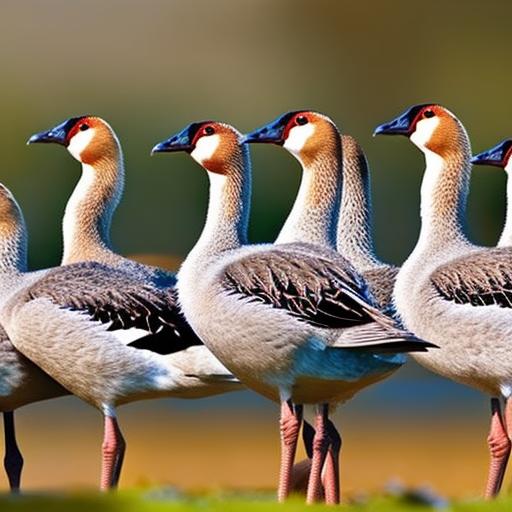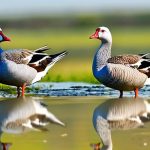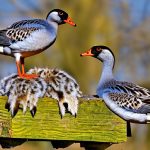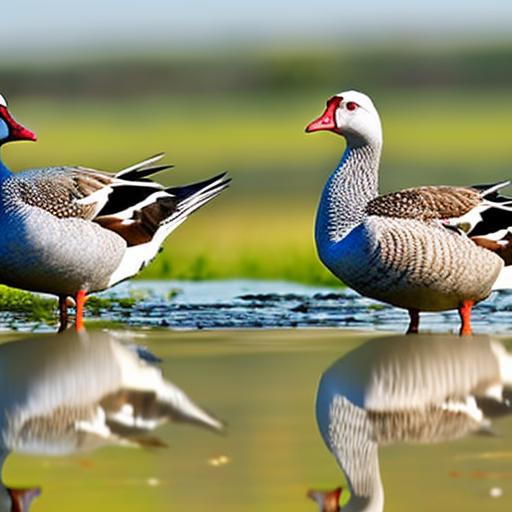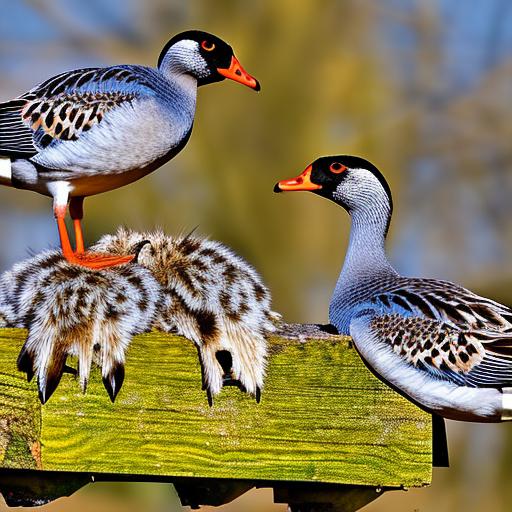Breeding geese can be a rewarding and fulfilling experience for farmers and hobbyists alike. Before diving into the breeding process, it’s important to understand the basics of geese breeding. Geese are monogamous birds, meaning they form long-term pair bonds with a mate. They typically breed in the spring and early summer, with the female laying a clutch of eggs and both parents taking turns incubating them. Geese are also known for their strong homing instincts, so it’s important to provide them with a safe and secure environment for breeding.
In terms of reproduction, geese reach sexual maturity at around 2 years of age. The breeding season for geese typically begins in late winter or early spring, with the female laying a clutch of eggs in a nest she constructs on the ground. The male will then guard the nest and help protect the eggs from predators. Once the eggs hatch, both parents will care for and protect the goslings until they are old enough to fend for themselves. Understanding these basic principles of geese breeding is essential for successfully raising healthy goslings.
Selecting the Right Breeding Stock
Selecting the right breeding stock is crucial for successful geese breeding. When choosing breeding geese, it’s important to select birds that are healthy, well-nourished, and free from genetic defects. Look for birds that are active, alert, and have good body conformation. It’s also important to consider the temperament of the birds, as aggressive or skittish geese may not make good breeding stock.
In addition to physical characteristics, it’s important to consider the genetic diversity of the breeding stock. Inbreeding can lead to genetic defects and health problems in goslings, so it’s important to choose breeding geese from different bloodlines. This will help ensure that the offspring are healthy and vigorous. Finally, consider the purpose of breeding geese. Are you breeding for meat, eggs, or as pets? Different breeds of geese have different characteristics and are suited for different purposes, so choose breeding stock that aligns with your goals.
Creating the Ideal Breeding Environment
Creating the ideal breeding environment is essential for successful geese breeding. Geese require a safe and secure space to build their nests and raise their young. Provide nesting materials such as straw or hay to encourage the geese to build their nests. It’s also important to provide protection from predators, as geese are vulnerable when nesting and caring for their young.
In addition to physical space, it’s important to consider the social dynamics of the breeding flock. Geese are social animals and form strong pair bonds, so it’s important to provide enough space for each pair to establish their own territory. This will help reduce aggression and competition among the breeding pairs. Finally, consider the climate and weather conditions in your area. Geese prefer cooler temperatures for breeding, so provide shade and access to water to help keep them cool during the warmer months.
Managing the Breeding Process
Managing the breeding process requires careful observation and attention to detail. Keep a close eye on the breeding pairs to ensure that they are mating and nesting successfully. If you notice any signs of aggression or stress among the geese, take steps to address the issue and provide a calm and peaceful environment for breeding.
It’s also important to monitor the condition of the nesting site and eggs. Check the nests regularly for signs of damage or disturbance, and make any necessary repairs or adjustments to ensure that the eggs are safe and secure. Keep track of the incubation period and be prepared to assist the geese if necessary. In some cases, geese may abandon their nests or be unable to care for their young, so be prepared to step in and provide care for any orphaned goslings.
Recognizing Signs of Successful Breeding
Recognizing signs of successful breeding is essential for ensuring the health and well-being of the geese and their offspring. Keep an eye out for signs of mating behavior, such as courtship displays and copulation. Once the female has laid her eggs, observe her behavior to ensure that she is incubating them properly and taking breaks to feed and drink.
After the eggs hatch, monitor the behavior of the parents and goslings to ensure that they are bonding and caring for each other. Healthy goslings will be active, alert, and vocal, while attentive parents will be protective and nurturing. If you notice any signs of distress or neglect, take steps to address the issue and provide support for the breeding pair.
Caring for Geese During the Breeding Season
Caring for geese during the breeding season requires attention to their nutritional needs and overall well-being. Provide a balanced diet that includes plenty of fresh water, grass, and high-quality feed to support the health of the breeding pairs and their offspring. It’s also important to provide access to shade and shelter from extreme weather conditions to help keep the geese comfortable during the breeding season.
In addition to physical care, it’s important to provide emotional support for the breeding pairs. Geese form strong pair bonds and can become stressed or anxious if separated from their mate or if their nesting site is disturbed. Provide a calm and peaceful environment for the geese to reduce stress and promote successful breeding.
Troubleshooting Common Breeding Challenges
Despite your best efforts, you may encounter common breeding challenges when raising geese. One common issue is egg infertility or poor hatch rates. This can be caused by a variety of factors, including age, genetics, nutrition, or environmental stress. To address this issue, consider consulting with a poultry veterinarian or experienced breeder for advice on improving fertility rates.
Another common challenge is predation on nests or young goslings. Geese are vulnerable when nesting and caring for their young, so it’s important to provide protection from predators such as foxes, raccoons, or birds of prey. Consider using fencing, netting, or other deterrents to keep predators away from the nesting site.
In conclusion, breeding geese can be a rewarding experience when approached with care and attention to detail. By understanding the basics of geese breeding, selecting the right breeding stock, creating an ideal breeding environment, managing the breeding process, recognizing signs of successful breeding, caring for geese during the breeding season, and troubleshooting common breeding challenges, you can raise healthy goslings and contribute to the preservation of these beautiful birds. With patience and dedication, you can enjoy the sights and sounds of geese raising their young in your own backyard.
Meet Walter, the feathered-friend fanatic of Florida! Nestled in the sunshine state, Walter struts through life with his feathered companions, clucking his way to happiness. With a coop that’s fancier than a five-star hotel, he’s the Don Juan of the chicken world. When he’s not teaching his hens to do the cha-cha, you’ll find him in a heated debate with his prized rooster, Sir Clucks-a-Lot. Walter’s poultry passion is no yolk; he’s the sunny-side-up guy you never knew you needed in your flock of friends!

